- Unki Platinum Mine recorded an 8% decline in Q3 2025 output to 57,500oz
- Rising electricity and input costs continue to pressure margins, even as the mine benefits from prior concentrator capacity upgrades
- The transition to Valterra Platinum and improving PGM basket prices may support longer-term stability, but overall recovery depends on Zimbabwe’s policy and power supply environment
Harare - Unki Platinum Mine, Zimbabwe’s third-largest producer of platinum group metals (PGMs), recorded an 8% decline in third-quarter to September 2025 production to 57,500 ounces, down from 62,200 ounces during the same period last year, according to the latest production update.
Now operating under the Valterra Platinum portfolio following Anglo American’s strategic restructuring, Unki’s reduced output was largely anticipated and stemmed from lower head grades in the current mining areas.
The grades across sections of the ore body mined this quarter were weaker, which in turn affected recoveries and overall refined PGM output. Despite the downturn, Unki remains a central pillar of Zimbabwe’s platinum industry, trailing only Zimplats and Mimosa.
Unki’s operations have, in recent years, benefited from expanded concentrator capacity through the 2022 debottlenecking project, which supported a 5% rise in total production to 243,800 ounces in 2023.
However, that operational advantage has been tempered by a tightening cost environment. One of the most pressing pressures for the mine and the broader sector has been escalating electricity costs, which now account for over 20% of mining revenues, alongside general input inflation and a persistent mismatch between local currency pricing and foreign currency revenue requirements.
These rising costs have constrained margins at a time when PGM prices have been soft, particularly for palladium and rhodium, both of which have corrected significantly from their pandemic-era highs due to a combination of weaker automotive catalytic converter demand and supply normalization.
Valterra’s group PGM sales volumes for the quarter decreased by 9% year-on-year to 936 800 oz, when excluding Kroondal which is a recent acquisition , but decreased by 15% including Kroondal.
Meanwhile, the company’s nickel production decreased by 15% year-on-year to 6 226 t, while copper production decreased by 9% to 4 201 t. Valterra says the prior comparable quarter included a larger release of work-in-progress inventory.
Total chrome production increased, however, by 10% from the comparative period to 271 000 t owing to higher volumes at Mototolo and improvements in yields across other operations.
Valterra benefited from a higher average realised basket price of $1 916/oz in the reporting quarter, which was 30% higher from the same period in the prior year and the highest average realised basket price since the first quarter of 2023.
Chief Executive Officer Craig Miller says the PGM price rally reflects a confluence of bullish macro-, micro- and sectoral drivers, including a weaker US dollar, robust precious metals investment amid rising inflationary fears and heightened geopolitical tensions, buoyant Chinese demand and concerns over metal availability in key trading centres.
‘’ The rally reflects a confluence of bullish macro-, micro- and sectoral drivers, including a weaker US dollar, resilient economic growth, robust precious metal investment amid rising inflationary fears and heightened geopolitical tensions, buoyant Chinese demand and concerns over metal availability in key trading centres,’’ he said.
The global PGM market continues to adjust from the sharp downturn experienced in 2024. Palladium has seen diminishing demand as global vehicle production shifts toward hybrid and electric vehicles, while rhodium prices have retreated from extreme highs, reflecting easing supply tightness.
Platinum, however, has shown signs of resilience, buoyed by increased substitution in auto catalysts in markets such as China and India, where internal combustion engine vehicles remain a significant share of new car sales. The recovery remains uneven, but it has provided some relief, particularly for producers like Unki that have been managing for stability rather than aggressive expansion.
In Zimbabwe, the PGM sector plays a more critical economic role than official trade data initially suggests. PGM exports are frequently recorded under the classification “nickel mattes”, referring to the partly processed material shipped to South African refineries.
This technical labelling can obscure the reality that PGMs are among Zimbabwe’s most valuable foreign currency earners, providing essential export stability, supporting thousands of jobs across Shurugwi, Zvishavane and Ngezi, and contributing significantly to government revenue through royalty and tax channels.
Alongside Unki, Zimplats and Mimosa form the backbone of this strategic export cluster, and even in periods of pricing pressure, their contribution remains indispensable to Zimbabwe’s trade balance.
The restructuring of Anglo American’s platinum operations into Valterra Platinum, and a London Stock Exchange listing, introduces new dynamics for the Zimbabwean PGM sector.
A listing would provide access to deeper global capital markets, increased transparency and governance benchmarking, and greater flexibility in financing capital-intensive mine-life extensions and processing investments.
It might also reposition Zimbabwean PGMs within a more globally visible value narrative, moving the sector away from a purely extraction-focused identity toward one aligned with long-term industrial metals demand, including anticipated hydrogen economy applications that rely on platinum.
However, the success of such a strategic transition depends partly on the domestic operating environment. Consistency in policy, reliable electricity supply, currency stability and clear beneficiation frameworks will determine whether Zimbabwe fully benefits from the repositioning of Valterra and the possible inflow of international investment it could attract.
If supported by policy stability and infrastructure reliability, Zimbabwe’s PGMs could be repositioned as a long-term growth industry rather than one merely surviving commodity cycles.
Equity Axis News





